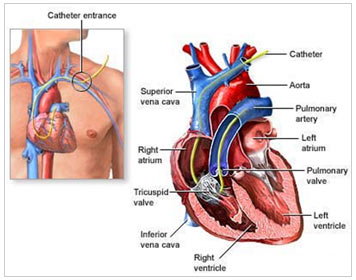Right Heart Catheter
What is a Right Heart Catheter?
This is a procedure where catheters are passed into the arteries and veins of the heart. Heart and lung pressures are monitored and blood samples are taken from within the heart.
How is it done?
The procedure begins with a tube (catheter) being put into the vein in the groin. You may feel pressure in your leg while the tube is placed in the vein. It is passed along until it reaches the heart and then goes up into the blood vessels of the lungs. This is painless. The doctor uses X-Ray imaging to see the catheter.
Pressures in the lungs and heart are recorded. A sample of blood is taken to look at the oxygen level. At the end of the procedure, the catheter is removed.
How do I prepare for it?

No food or drink 3 hours prior to the procedure




After the procedure





What are the risks?
In recommending this procedure, your doctor has balanced the benefits and risks of the procedure against the benefits and risks of not proceeding. Your doctor believes there is a net benefit to you going ahead. This is a very complicated assessment.
Common risks (more than 5%) –
- minor bleeding and bruising at the puncture site
- abnormal heartbeat lasting several seconds which settles by itself
Uncommon risks (1-5%) include –
- unable to get the catheter into the leg vein. The procedure may be changed to the opposite leg or to a different approach e.g. the neck or an arm vein.
- abnormal heart rhythm that continues for a long time. This may need an electric shock to correct.
- The femoral artery (in the groin) is accidentally punctured. This usually just requires pressure on the artery. However, rarely this may require surgery to repair.
Rare risks (less than 1%) include –
- infection. This will need antibiotics.
- allergic reaction to the local anaesthetic. This may require medication to treat.
- embolism. A blood clot may form and break off from the catheter. This is treated with blood thinning medication.
- clots in the leg (deep venous thrombosis or DVT) with pain and swelling. Rarely part of this clot may break off and go into the lungs.
- damage to the vein in the leg. This may need surgery to repair.
- damage to the lung blood vessel causing bleeding, This may need surgery to repair.
- air embolism. Oxygen may be given.
- a hole is accidentally made in the heart or the heart valve. This will need surgery to repair.
- unable to position the balloon catheter into the lung vessels or around the heart. The procedure would be cancelled if this occurred. This is more common if there are congenital malformations of the heart.
- damage to the nerve in the leg.
- a stroke. This may cause long term disability.
- death as a result of this procedure is extremely rare.
If you have any further questions, please contact us at:
Queensland Cardiology
St Vincent’s Private Hospital Northside
North Medical Suites, Green Lifts Level 3,
627 Rode Road
Chermside Q 4032
(07) 3861 5522

